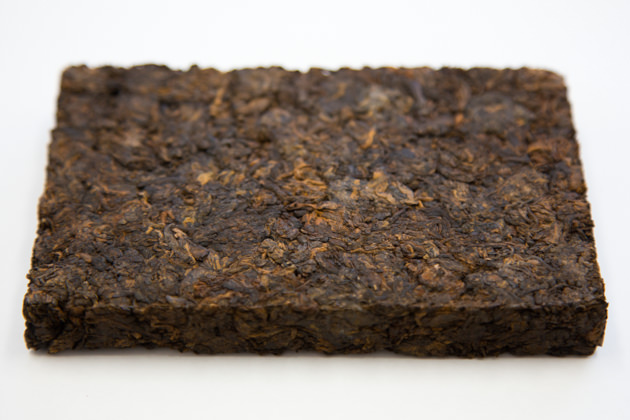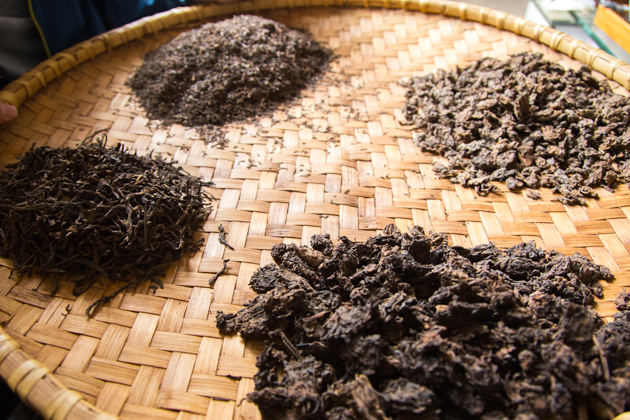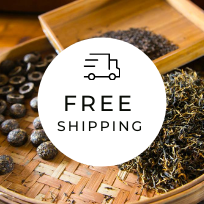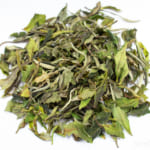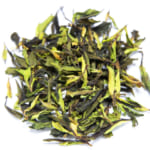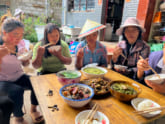- HOME >
- New Arrival at HOJO Online Shop
New Release of Cha Tou Ripe Pu-erh Tea 2015
- [2017.02.24] Posted By Akira Hojo
We purchased Cha Tou 2015 when we visited Yunnan in 2016. This tea was produced in the village located about 50km away from the Myanmar border. The tea was grown with the natural farming method which no pesticide or fertilizer is used.

Even after the compression we still can observe the Cha Tou
Cha Tou is the lumps of tea produced by microorganism during tea fermentation
Cha Tou means “the head of tea” in both Chinese and Japanese. Technically, Cha Tou is the lumps of tealeaf coagulated during the fermentation due to the polysaccharide produced by the microorganism. There is no oxygen inside Cha Tou. Because of this fact, it undergoes very unique maturation during the process.
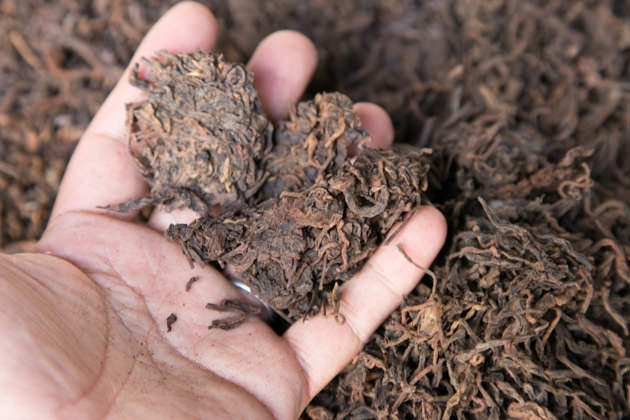

Small Cha Tou
Small Cha Tou
There are two types of Cha Tou: the big Cha Tou and the small Cha Tou. Sometimes the tea manufacturer even classifies it into three categories. They may have mini Cha Tou as well. We used big Cha Tou for our earlier lineup, the Cha Tou Ripe Pu-erh 2012. However, we selected small Cha Tou for 2015 crop. The size of the small Cha Tou is about 1cm or slightly bigger.

It is extremely rare to make ripe pu-erh tea from spring tea
The majority of the ripe pu-erh tea is produced after blending all batches of tea collected in late spring, summer and autumn tea. The manufacturer conducts blending in order to even out the price and the overall quality. This is the typical production style of ripe pu-erh tea in big factory with mass production scale.
In other words, it’s extremely rare to find ripe pu-erh tea produced from only spring tealeaf in commercial tea market. If you have ever tried the ripe pu-erh tea produced from the spring crop, there is a huge difference in quality compared to the blended tea. The spring tea gives a mellow and silky soft drinking sensation with long lasting sweetish aftertaste.
Our tea is always from the spring crop. Every year we visit the tea manufacturer in early spring to look for the spring tea.

Ripe pu-erh tea was invented in 1970s. It has a very short history as compared to the raw pu-erh tea that has more than 700 years of history. However, in oversea market, a lot of people associate ripe pu-erh tea as the “pu-erh tea”. The ripe pu-erh tea is produced by the microbiological fermentation. During the fermentation, the substance that gives astringency such as EGCg is being oxidized and decomposed.
If tea is produced from early spring crop, regardless of raw or ripe pu-erh tea there is no astringency. On the other hand, if raw pu-erh tea is produced from summer tea, it gives strong astringency. However, once the summer tea is fermented into the ripe pu-erh tea, it gives no astringency thanks to the reason mentioned above. Consequently, summer tea-based ripe pu-erh tea is well accepted and often more famous than raw pu-erh tea in oversea market.
Earthy smell is due to the failure of process management
Many people commented that ripe pu-erh tea tends to give earthy flavor like old furniture smell or soil. This type of smell is called camphor smell that gives impression like traditional Chinese medicine. In fact, this smell is developed if ripe pu-erh tea is not produced in a proper manner. It is due to the failure in fermentation.
There are a number of microorganisms that involves in the fermentation of ripe pu-erh tea. Usually the anaerobic and aerobic bacteria actively involved in the initial stage and subsequently it is taken placed by the yeast and mold. However, if too much water is being applied, tea leaves are over wet and there is insufficient oxygen. As a result, anaerobic bacteria dominate the fermentation and it will produce substances that give unpleasant smell.
We never purchase tea once we detect camphor smell. Unfortunately, a lot of pu-erh teas are poorly made and gives earthy smell. That is the reason why a lot of people have negative impression with ripe pu-erh tea. The well-produced ripe pu-erh tea gives sweet dry-fruity flavor.
Aging further enhances the flavor of Cha Tou
The Cha Tou is giving a mild sweet fruity flavor even if tea is still fresh.
However, the best timing to drink this tea is after being kept for a few years (if tea is kept in warmer climate. In case the tea is kept under cooler environment, the maturation will takes longer period of time).
It develops very unique and complex flavor like dried dates with a hint of raisin note.
Related Articles
How to get the latest update on HOJO Tea?
1. Follow Twitter, 2. Click "Like" on Facebook, and 3. Subscribe in newsletter. You can have the latest tea news from HOJO Tea.
 Subscribe the Newsletter to enjoy the privileges
Subscribe the Newsletter to enjoy the privileges- You may receive a free sample upon purchase, or you may have the priority to purchase special products. So please remember to subscribe our newsletter as well as the social network.
- Yunnan Chun Jian Green Tea from High Mountain Gardens
- Yunnan Chun Jian Green Tea is now available.This tea is made from naturally grown leaves harvested from high mountain gardens at 2100m above sea level. It has a rich, long-lasting lingering aftertaste, comparable to raw Pu-erh tea. Yunnan as a Distinctive Tea Growing Region Over the past 20 years, we have explored a wide range …
- Limited Loose Leaf Release of 2025 Da Xue Shan Wild Raw Pu-erh Tea
- We have released the 2025 loose-leaf version of Da Xue Shan Wild Raw Pu-erh Tea.This tea comes from wild tea trees that grow naturally in the high mountains of Yunnan Province, at elevations above 2000 meters. This year, we were only able to secure a small quantity for retail, and the current release is available …
NEW ARTICLES
 Yunnan Chun Jian Green Tea from High Mountain Gardens
Yunnan Chun Jian Green Tea from High Mountain Gardens- Yunnan Chun Jian Green Tea is now available.This tea is made from naturally grown leaves harvested from high mountain gardens at 2100m above sea level. It has a rich, long-lasting lingering aftertaste, comparable to raw Pu-erh tea. Yunnan as a Distinctive Tea Growing Region Over the past 20 years, we have explored a wide range …
 Limited Loose Leaf Release of 2025 Da Xue Shan Wild Raw Pu-erh Tea
Limited Loose Leaf Release of 2025 Da Xue Shan Wild Raw Pu-erh Tea- We have released the 2025 loose-leaf version of Da Xue Shan Wild Raw Pu-erh Tea.This tea comes from wild tea trees that grow naturally in the high mountains of Yunnan Province, at elevations above 2000 meters. This year, we were only able to secure a small quantity for retail, and the current release is available …
 2025 Da Xue Shan Wild White Tea Now Available from Yunnan
2025 Da Xue Shan Wild White Tea Now Available from Yunnan- The 2025 harvest of Da Xue Shan Wild White Tea is now available. Crafted from truly wild Camellia taliensis trees growing naturally in the high-altitude forests of Yunnan, this tea offers a purity and character unique to its origin. This year’s unusually dry climate during the withering season was ideal, resulting in a floral and …
 Why Do Some Teas Taste Astringent? Exploring the Causes and Mechanisms of Astringency
Why Do Some Teas Taste Astringent? Exploring the Causes and Mechanisms of Astringency- Tea can range from having no noticeable astringency to possessing a very strong one. What causes this astringency? This article explores the causes and mechanisms behind astringency in tea. Causes of Astringency Astringency arises from the binding of tea components to proteins in the oral cavity, creating a sensation of tightness or dryness. The tongue …
 The Impact of Heat Sources on Tea Flavor
The Impact of Heat Sources on Tea Flavor- It is widely recognized that the material of a kettle plays an important role in shaping the taste of water for brewing tea. Yet, an often overlooked but equally significant factor is the type of heat source used to boil the water. Different heat sources, whether gas, electric, charcoal, or wood fire, can impart distinct …
 New Release of High Mountain White Tea
New Release of High Mountain White Tea- We are pleased to introduce our High Mountain White Tea, sourced from a unique tea garden with two key features: 1. Located at an altitude of 2200-2300m2. Completely wild and untended The ideal natural conditions of this garden result in tea of exceptional quality, offering a pure and gentle, nourishing taste. High Altitude and Wild …
 New Release of Da Xue Shan Wild White Tea 2024
New Release of Da Xue Shan Wild White Tea 2024- We have released the 2024 Da Xue Shan Wild White Tea Loose Leaf. This tea was produced under our direct supervision during our stay in Yunnan Province, ensuring meticulous production management on site. Definition of Wild Tea in Yunnan Province People in Yunnan strongly associate Camellia taliensis with wild tea, regardless of where it is …
 New Release of Wild Pu-erh Jasmine Pearl
New Release of Wild Pu-erh Jasmine Pearl- Out of curiosity, we decided to create a jasmine tea based on Da Xue Shan Wild Raw Tea. This resulted in an exceptionally rare tea, not only in Japan but also in China. Custom Production Network for Jasmine Tea At our store, we source various types of base teas from different regions during the spring. …
 2024 Overview: Our Yunnan White Tea Quality, Process, and Weather Insights
2024 Overview: Our Yunnan White Tea Quality, Process, and Weather Insights- One of the teas we’ve been focusing on in Yunnan Province is white tea. Historically white tea has been produced in both Fujian Province and Yunnan Province for a long time. While white tea from Fujian Province is well-managed during processing, we are dissatisfied with the quality of the raw materials due to the use …
 Yunnan’s Hospitality Culture: Expressed Through Meals
Yunnan’s Hospitality Culture: Expressed Through Meals- In China, as a form of greeting, it’s common to say “你吃饭了吗?” which means “Have you eaten?” However, in Yunnan Province, the phrase “吃饭” is often used in various situations, more like “Eat, eat,” serving as an invitation to share a meal. Yet, with prolonged exposure to Yunnan, one comes to understand that these meal …
Shop Info

Address:Lot No. T-215, 3rd Floor, The Gardens Mall, Mid Valley City, Lingkaran Syed Putra, 59200 Kuala Lumpur
Tel: +603-2287-4537
Business Hour: 10am to 10pm
Category
- New Arrival at HOJO Online Shop
- Featured Articles
- Newsletter
- Types of Tea
- Origin of Tea
- Teapot and Tea Equipment
- Tea Column
- How to enjoy tea
- Tea Processing
- How to choose quality tea
- Tea constituents and functional effect
- Safety of Tea
- Foods
- Tea Business Operation
- Hobby and Outdoor Activity
- Ranking of Tea
- Video
- FAQ
- Media Release
Profile

- AKIRA HOJO
- I invite you to experience my tea selections.I was born in Nagano, Japan. In university, I studied agricultural chemistry, and I have the master degree in food science. I worked in Japanese food industry for 10 years. I involved in R&D, QC and QA. As a factory manager, I implemented ISO9000 series and managed the factory.
- The Art of Tea Magazine
- We posted the article on “The Art of Tea Magazine No.9, the magazine is published in Taiwan. We featured some scientific view about the tetsubin
- New Straits Times
- The Malaysian National Newspaper, New Straits Times featured HOJO Tea on 17-Oct-2007.

